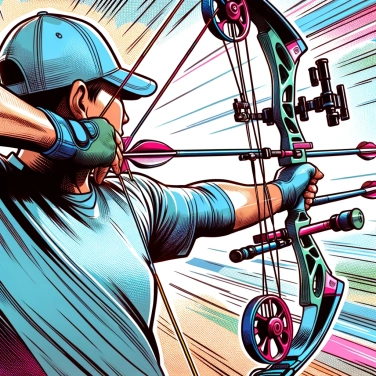Some archers use stabilizers on their bow to reduce vibrations, stabilize the movement of the bow when shooting, and improve accuracy by neutralizing the effects of the shooter's arm and hand on the bow's stability.

A stabilizer helps keep the bow straight and stable when shooting. It prevents the bow from moving slightly, which would cause your arrow to miss its target. The less unwanted movement there is, the more accurate your shot is. Additionally, the stabilizer slightly extends the bow forward, which increases inertia: basically, it's harder for the bow to move accidentally. This allows the archer to better control their motion and place each shot exactly where they want it.
When an arrow leaves the bow, the released energy causes unpleasant vibrations in the grip. The stabilizer absorbs these vibrations through a system of weights, damping materials, or small anti-vibration devices. This also helps to reduce the recoil, that uncomfortable sensation that slightly pushes the bow backward after the release. Less vibration and less recoil mean essentially more comfort and less fatigue for the archer. A less tense archer inevitably gains consistency and accuracy over time.
When you aim, the bow tends to move or shake slightly due to your breathing or involuntary muscle tension. The stabilizer acts as a sort of counterweight that prevents these movements from intensifying. As a result, your bow stays steady on target for longer. The stabilizer bar essentially serves as a balancing pole; it extends the bow and lowers its center of gravity. This means the bow moves less easily from side to side or up and down—like a car with a wide wheelbase that stays better on the road. The more stable your equipment is, the more precise and consistent your aim will be.
A bow equipped with a stabilizer is easier to hold straight and does not tilt forward or backward. It avoids an unpleasant feeling of imbalance during aiming. As the extra weight is distributed forward and on the sides, the stabilizer helps achieve a more natural balance of the bow in the archer's hand. It also reduces muscle fatigue, as the archer exerts less effort to compensate for a poorly balanced bow. With a well-distributed weight, the archer gains comfort and endurance during long training sessions or competitions.
For many archers, adding a stabilizer to their bow provides essential mental assurance. Seeing that the bow remains stable on target gives them serenity at the moment of release. Less stress, fewer doubts, and better focus on the shot itself. This feeling of total control helps the archer feel at ease, especially in competition or during key moments. In this way, a stabilizer acts a bit like a silent ally that discreetly boosts their confidence.
Studies have shown that stabilizers can reduce the vibrations felt by the archer by over 30%, thus limiting the risk of long-term injuries.
The stabilizer of a modern bow is typically made of carbon fiber to be lightweight and rigid while effectively absorbing vibrations.
Some archers use multiple lateral stabilizers, in addition to the main stabilizer, to better balance their bow according to their personal archery style.
The first stabilizers used in competitions appeared between the 1950s and 1960s, thereby revolutionizing the accuracy and consistency of competitive shooting.
A well-installed stabilizer allows your bow to be stable and balanced during shooting, without leaning forward, backward, or to the side. Try different configurations to find the one that provides the best comfort and accuracy during practice.
Yes, many archers use a combination of stabilizers (central and lateral) to achieve the ideal balance of their bow. However, be careful not to overload your equipment unnecessarily, as this may affect your shooting technique.
No, stabilizers are not mandatory for beginners. However, they can greatly facilitate learning by reducing unwanted movements and quickly improving shooting accuracy.
Yes, the size and weight of the stabilizer vary depending on the type of bow (recurve, compound, traditional) as well as the type of use (competition, hunting, recreation). It is important to choose a stabilizer that is suited to your equipment and shooting style.
Not necessarily. The choice of the weight and length of a stabilizer depends on the archer's personal comfort, physical strength, and the best balance achieved with their own equipment. If it's too heavy, it could lead to fatigue and a loss of accuracy in the long run.

No one has answered this quiz yet, be the first!' :-)
Question 1/5